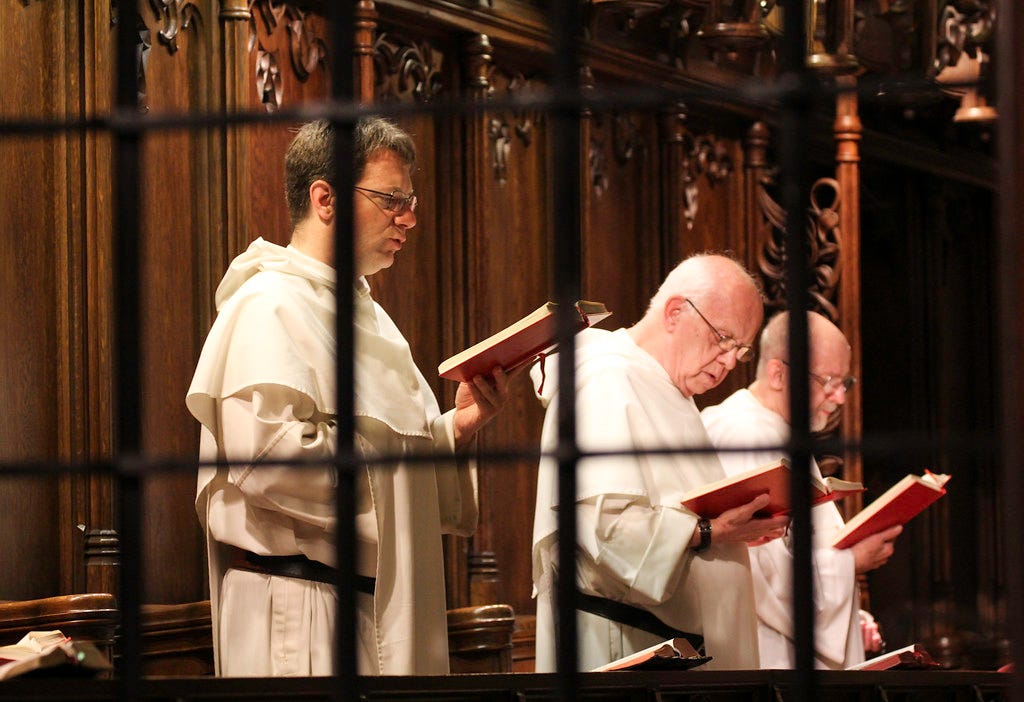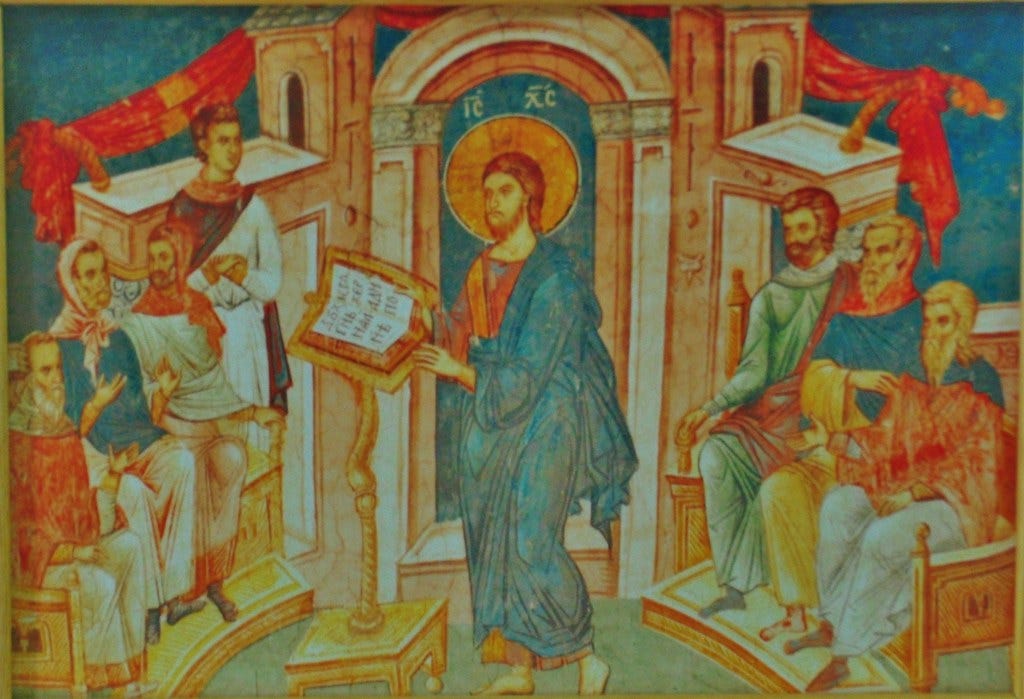Some Guidelines for Christian Prayer
A Bit of Spiritual Direction
Ruth Burrows' book Guidelines for Mystical Prayer impacted my practice of prayer like no other book or person.1 After absorbing Burrows' direction concerning prayer, it seemed whatever I did before wasn't prayer at all compared with my attitude in prayer afterwards. Not that I learned some new method of prayer, for if we seek success in prayer by seeking some particular method, we miss the point. Prayer is not about success, because when we think of success, we generally mean the accomplishment of some utilitarian goal. Prayer is not useful to us in that way. And after a lifetime of prayer, when we do attain the goal of prayer, and when we could say that our prayer has been a success, I daresay words both weightier and holier will come to mind. So, Burrows does not offer methods of prayer sure and certain to succeed, but an approach to the life of prayer gleaned from her personal experience and from the direction of St. Theresa of Avila. She describes the way of prayer as the most natural and fitting way of being human that many of us never attempt. Her book transformed my life, because simply put it caused me to attempt the life of mystical prayer in earnest.
For, Burrows understands the life of prayer according to the pattern of God's grace in the human life. Thus, when she describes the life of prayer as mystical, she means nothing more than Jesus, who embodies the mysterious union of man and God. All Christian prayer seeks the mystical union of humanity and divinity, because Jesus Christ as the true man, man fully created in the image and likeness, perfectly living according to the will of God, and fully united to the divine life reveals the end and goal of mankind. Therefore, the mystical life does not represent an arcane path for a few enlightened seekers, but rather the straight and narrow path God invites us all to trod toward eternal life. Burrows determines the great spiritual divide in mankind is not between mystics and non-mystics but between "pre-mystics" and those who become fully alive united to the divine life according to God's love. We all begin as pre-mystics for Jesus Christ is the destiny of all mankind; he defines what it means to be human. When we remain pre-mystics, we fail to be fully and truly human. Instead, when we turn to God, his grace is sufficient for us.
So, how do we move from pre-mysticism to the life of mystical prayer? Well as I noted previously, no one method makes a man a mystic, no bit of esoterica exists to make one a saint, and we will not awake some morning to discover some secret and special part within ourselves marking us out from the rest of mankind. God gives his life to us as eternal life. He makes us holy. And he draws all men to himself according to his love revealed in Christ. But all the same, guidelines in the life of prayer prove helpful. The first guideline, above all else and from which all prayer flows, requires us to actually sit and pray: schedule a time each day, perhaps in the beginning for only five or ten minutes, sit, and pray. With that said, in the next couple of weeks, I hope to offer an introduction to some common and traditional forms of Christian prayer. For, God uses varied and sundry ways to turn our hearts to him.
The Daily Office
Foremost the Daily Office consists in praying the Psalms as a response to St. Paul's command to "pray without ceasing."2 The Daily Office Lectionary appoints the Psalms to be recited either every thirty days or every six weeks. The Psalms contain a wide range of human experience of life and attitude toward God. As we pray the Daily Office, the Psalms become our prayer language, and express thoughts that we do not know how to phrase or else remain too timid to pray.
The Daily Office represents an ancient Christian, and especially monastic, practice. It consists in as few as two and as many as eight services. Two traditions for the Daily Office emerged in early Christianity. In cathedrals Matins and Vespers were attended by lay people. Matins and Vespers marked the beginning and ending of each day. In the monasteries eight hours were observed: Matins, Lauds, Prime, Terce, Sext, None, Vespers, and Compline. These hours were mostly observed by people in religious life.
As an Episcopal Priest, I use the Book of Common Prayer to keep the Office. The Book of Common Prayer includes all eight monastic offices, for those creative with its rubrics: Matins/Lauds (Morning Prayer, BCP, pp. 37-60 or 75-102), Vespers (Evening Prayer, BCP, pp. 61-73 or 115-126), and Compline (BCP, pp. 127-135).3 Less used, the "Noonday Prayer" (BCP, pp. 103-107) and "Daily Devotions" (BCP, pp. 136-140) sections in the Book of Common Prayer (1979) can be used to pray the minor hours of Prime, Terce, Sext, and None. However, a Roman Breviary would more straightforwardly account for these hours.
Praying the Daily Office regularly grounds the life of prayer in reading and praying Scripture. The Daily Office, as the name implies, is not intended for occasional use, but invites the Christian to develop a habitual practice. Indeed, the "Daily Office" from the Latin "officio" implies duty. To pray the Daily Office does constitute the Christian's duty in and of itself, rather our duty is to offer worship and praise to God, and the Office serves as the way we fulfill this obligation. The Daily Office, then, serves us as an aid, making the words of Scripture our own as we say or sing praises to the glory of God.
Lectio Divina
Lectio divina means divine reading and consists in praying with the Scriptures. This practice naturally follows the Daily Office because it was a practice developed by Christian monks immersed in the daily reading of Scripture. Whereas our modern impulse is to read Scripture for information about ethics or history, the ancient Christian impulse was to read Scripture to know and love God more deeply. We need not pit Bible study against praying the Scriptures, for both inform the Christian life, yet I wonder how many modern Christians know about and practice lectio divina. For many Christians, praying the Scriptures remains a lost art.
Four steps compose the practice of lectio divina: lectio (reading), medatio (meditation), contemplatio (contemplation), and oratio (oration or prayer). These steps do not work like the steps of an instruction manual and should not be thought of as individual tasks. Instead, these steps describe the flow and direction of prayer while practicing lectio divina. Also, these steps describe the practice of reading, but more preparation is required. Before sitting down with a Bible to pray, you should have already selected a passage of Scripture. The Daily Office Lectionary (BCP, pp. 934-1,001) makes for a helpful guide in selecting a pericope. Also, you should prepare your space and yourself. Quiet solitude creates an environment that encourages prayer. Then, you begin to read. Read through your selected passage slowly and carefully several times. Dwell on a word or phrase that draws your attention. Next, in meditation think about what you have read. Take your time. You need not be able to explain the passage of Scripture. Think about what you love in the passage. Then, in contemplation open yourself to God's presence in the words of Scripture. Wonder about what God might be revealing to you of himself in Scripture. Finally, if moved by the Spirit, enter into conversation with God about what you discovered about him in his Holy Word.
In the practice of lectio divina, as with all prayer, we seek familiarity with God. We become attuned and acclimated to God's presence. When we read Scripture in prayer, we do not seek doctrinal insights to teach to others, or facts about the Bible, or how to be a better person; all the uses we might have for the Bible dissolve as we rest in God's presence. The goal of lectio divina is participation in the divine life. We read and pray to spend time with God, to abide in him, and to grow in friendship with him.
To be continued...
Ruth Burrows, Guidelines for Mystical Prayer (New York: Paulist Press, 2007).
I Thessalonians 5:17.
In the original English prayer books, Thomas Cranmer combined some monastic offices with the cathedral offices to create Morning and Evening Prayer. Lauds and Matins became Morning Prayer, and Vespers and Compline became Evening Prayer.






